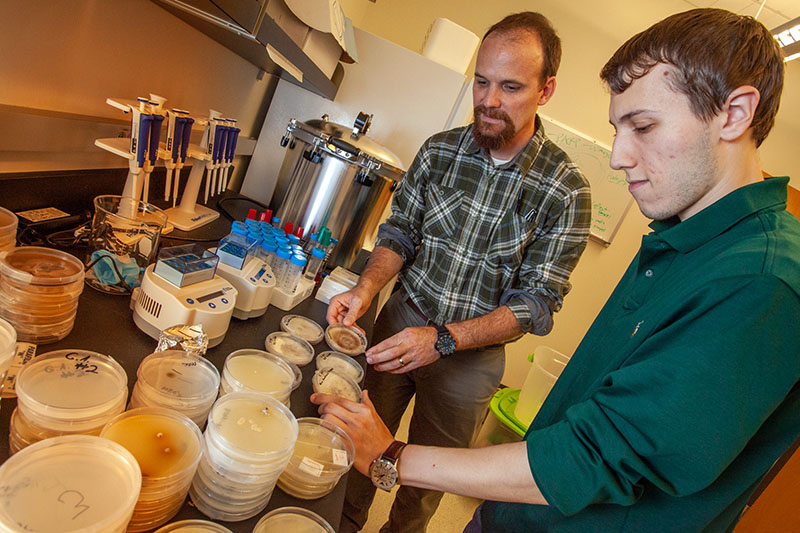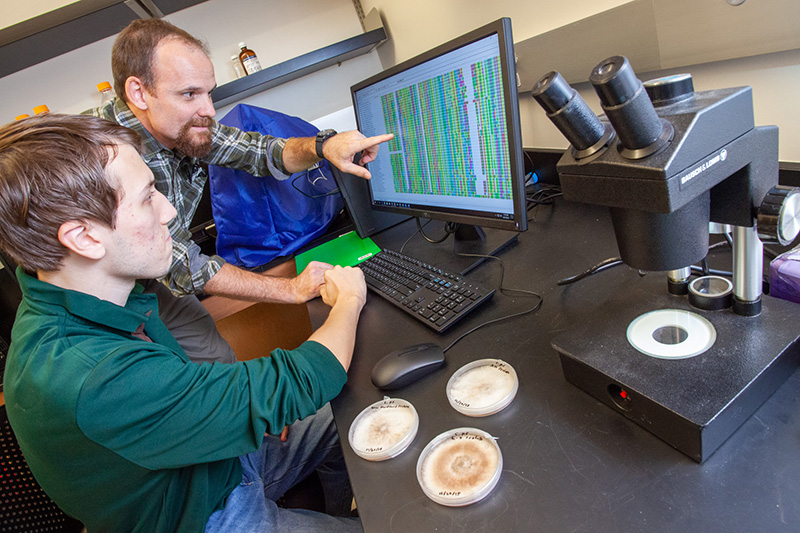- Apply
- Visit
- Request Info
- Give
Biology duo publishes on antifungal resistance and boxwood blight
Written by Molly Boucher
Published on September 03, 2021

Eastern Connecticut State University alumnus Stefanos Stravoravdis ’20 and his faculty mentor, biology professor Jonathan Hulvey, were recently published in the International Journal of Molecular Sciences. Their manuscript, “Evidence for the role of CYP51A and xenobiotic detoxification in differential sensitivity to azole fungicides in boxwood blight pathogens,” is the product of two years of collaboration between Hulvey and Stravoravdis, as well as research scientists with the United States Department of Agriculture (USDA) and Connecticut Agricultural Experiment Station in New Haven.
The article presented findings from a study that applied mRNA sequencing and bioinformatics to understand which genes are involved in antifungal resistance. The research stems from Stravoravdis’ time as an undergraduate at Eastern, and analyzes the impact of the CYP51A gene, as well as detoxification genes, which help to create a reduced sensitivity to fungicides in C. henricotiae (Che). Che and its sister species, Calonectria pseudonaviculata, cause boxwood blight, an invasive fungal disease of boxwood ornamental plants, known primarily for their aesthetic use. This disease is causing problems for growers in Connecticut and worldwide.
As a part of his Honor’s Program thesis, Stravoravdis collaborated with Hulvey, who needed a student to help him with some of his unfinished research. “I thought I could learn some useful skills while studying interesting fungal pathogens,” says Stravoravdis. “It was a lot of computer work, but eventually during September of my senior year, I had finally completed all of the analyses for my Honors thesis.”

Throughout their collaboration, the duo completed two published manuscripts, which Stravoravdis says is only the beginning of this research’s journey. “I do consider this as a good final product for me personally. However, by no means is this work actually complete, as we only analyzed gene expression data for these two pathogens when exposed to one class of antifungal chemicals. There are more chemicals out there to use and explore fungicide resistance, and, in reality, this manuscript is still somewhat preliminary.”
With the help of Hulvey, Stravoravdis was able to explore new opportunities with their research, such as the Pioneer Valley Microbiology Symposium at the University of Massachusetts Amherst. When interviewing for the University’s Ph.D. program, many of the students and faculty remembered his talk. Pursuing grants and publications, which Hulvey often encouraged “is exceptionally important for someone intending on continuing with scientific research,” says Stravoravdis, who is now in his Ph.D. program at the University of Massachusetts Amherst.
The mentor and student relationship between the two was incredibly strong, says Stravoravdis. “I have always felt that a mentor should be easy to communicate with. To learn, you need to be willing to discuss the project, the data or the concepts. At no step of this process did I feel as though Dr. Hulvey was too busy to talk or help me learn. Even after I graduated, that line of communication never stopped, which was essential to finally finishing off this project.” Stravoravdis also found himself continuously supported by additional members of Eastern’s Biology Department. “There always seemed like there was someone around to chat about my work and think about it in different ways,” he says. “Both of my reviewers consistently provided good feedback about what I was doing, thereby helping me rework my analyses and writing to yield a better product.”
Although the research completed in his undergraduate studies at Eastern has not directly connected to his research at the University of Massachusetts Amherst, Stravoravdis has found that the skills he gained can be applicable anywhere. Hulvey commented that “Stefanos is a glowing example of what our students are capable of achieving.”
Stravoravdis currently is working with mycobacteria, which is very different from fungal plant pathogens. However, “the bioinformatic skills I picked up can be adapted for any project,” says Stravoravdis. “I suppose that is part of the draw of research for me; if I think something is interesting, I want to study it and try to find something new and cool to learn and talk about. If you’re too closed-minded, you run the risk of missing out on uncovering something really fascinating.”
This research was done in collaboration with Robert Marra, research scientist with the Connecticut Agricultural Experiment Station in New Haven, and Joanne Crouch, research molecular biologist with the USDA Agricultural Research Service.


